Kudzu, Pueraria montana: Preparing kudzu vines for weaving baskets
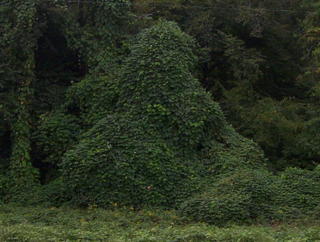
Harvesting:
Although kudzu can be harvested anytime of year, July through the first frost are the prime times to pick kudzu's long, tough runners. It's best to find a field with long runners on the ground, as it's quite difficult--and dangerous--to pull kudzu out of trees. After the summer solstice, the fast growing green kudzu vines begin to get fibrous, making them durable!
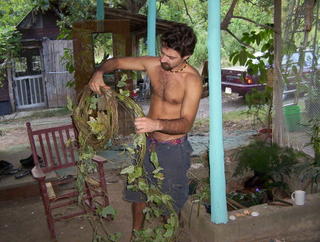
Kudzu, as well as most weaving material, needs to be dried thouroughly, then rehydrated just enough before working with it. If green vines are weaved, the basket will be loose and not very durable. This being said, all of my early baskets were made out of green vines. If they loosened up, I'd just weave more vines into them. Also, some materials don't shrink as much as others, so it isn't as noticable--such as grapevine, which has minimal shrinkage. A new weaver, full of enthusiasim, doesn't really need to burden himself with weeks--months even--of prepwork before attempting to weave a basket! He might try weaving and decide it isn't for him. If you have the desire, just go pick some vines, and do it.
Kudzu vines can be weaved whole, green, or after drying and rehydrating, or they can be processed into finer fibers, which can be dyed. Store kudzu in loose coils (like wrapping a hose up on your arm), in a dry location. Sunlight helps change the green colored vines to a more pleasant brown.
If you'd like some guidance while experimenting with kudzu, here's how I prepare the fibers:
At any point in this process, you can just coil the vines, dry them, and return to working with them later.
By the time the vines are ready to weave, they will have been coiled and uncoiled several times. Grade the kudzu according to size as you work. It's much easier to select a 'thin' vine from a pile of thin vines, than from a pile of all sizes jumbled together.
Go gather some vines. They are various shades of green, and some are gray. The greenest vines are the freshest growth. They grey vines are last years, or older. Pick any and all. I like to find vines the diameter of my pinky finger. Coil them into manageable loops. If you are going to completely dry these vines before you get back to working them, be sure to make your coils small enough to fit in your soak pot, whether a wash tub, bath tub, or stock pot. If the weather is nice, and you live in a rural location, you can soak your kudzu in a river, or lake, and weave while swimming/sunbathing.
Cleaning and sorting:
It's easiest to work with kudzu soon after it has been harvested. Uncoil the kudzu you've gathered, remove the leaves and twigs, and separate vines according to thickness. Be sure to recoil the vines into coils smaller than the diameter of your stock pot! The thinnest, greenest vines, are fragile right after picking, and need to be handled without kinking them. They lose about 70% of their weight during drying. They are extremely brittle before mellowing, so be careful not to crunch them during dry storage or while rehydrating.
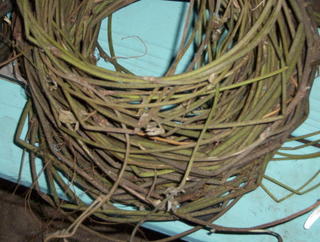
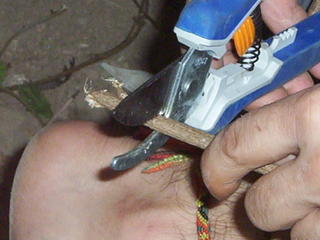
Splitting:
The larger vines should be split. Clip the end off so you have a smooth surface to start splitting. Using a kitchen knife, start to split the vine in half lengthwise, right through it's pithy center. Once you've split the vine, recoil it for storage.
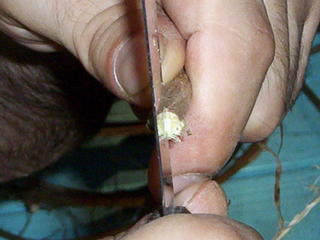
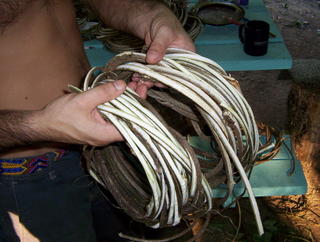

Cooking:
Carefully lower the kudzu into a stockpot of hot water. There is some debate about whether or not to boil the vines. I prefer to boil mine until they are good and soft, but I have been accused of over-cooking things before. If you are cooking dried vines, dip each end of the coil into the water before cramming the vines into the pot. This softens them a little, making them less likely break. Cook the kudzu until the pithy center changes from white to clear--it's much easier to scrape off. You might need to take it out of the water and test it. Different thicknesses may require different cooking times. You can use a variety of implements to scrape the pithy center out, such as this sea shell. A round-tipped knife also works. Generally, I prefer to scrape the pith while the bark is still on.
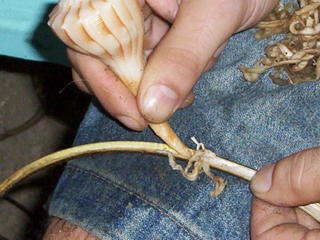
Peeling:
Next peel off the bark. Uncoil a vine after it cools a bit. Using the index finger of one hand, hold the bark and vine apart. Pull on the bark with the other hand away from you. Use which ever hand feels natural. Be sure to save the bark in loose coils--it looks like dried emuskin when woven!
Recoil all of the kudzu.
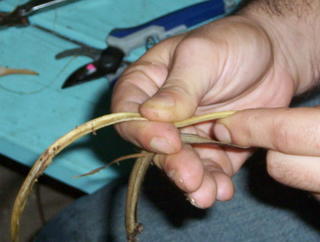
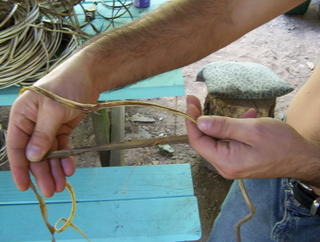
Refining the weavers:
Next, uncoil a piece of split, cooked, depithed, and peeled kudzu, and split it again lengthwise with a pocket knife. Most of the pieces will have a split started. Just fullow the grain in the vine, and you'll be fine. Try to make the pices a consistent thickness. Coil them as you go.
The kudzu stockpile now consists of: thin green vines, split white fibers, bark, and whatever whole kudzu you've decided not to split. the kudzu is ready for weaving (or you could dye the split vines).



15 Comments:
I am wanting to know if I could use kudzu vines for wedding greenery. Will the leaves hold up fro a couple of days after being harvested?
Hi, I was just wondering how you would de-pith an unsplit kudzu vine, since the pith is in the center. Thanks!
Megumi, You can't as far as I know. The vine must be split.
Cathy,
Sorry: I just saw your question:
Kudzu leves are very delicate and start to wilt almost immediately.
Just found your blog and I am enjoying reading about the kudzu items that can be made. We have kudzu that covers the bank behind our house and then some that comes down from the railroad track. I have tried EVERYTHING to get rid of it, because of it's 'destructiveness' on our property. Now that I know things can be made out of it I want to start harvesting it and try to collect all the money we have lost over the years to kill it.
My question is this, Can I harvest it after it goes into its dorement stage?? Like in the cooler months. Our chickens eat the leaves, so I can harvest most anytime I guess.
YES. Kudzu can be harvest during the cooler months...but, the thinnest vines will be unusable, only the larger ones that are starting to turn from green to grey. Thanks for reading!
I majored in Fibers but didn't do much basket weaving. I work in an organic garden and would love to weave some baskets with the tomato vines and hyssop that we just took out. Any helpful tips or should I just follow your suggestions for Kudzu.
Lauren, I've never weaved with tomato. Let me know how it works!
Hi I was wondering if you knew anything about how I might use the stalks from my mammoth sunflowers...I have some over 14' tall and the stalks as big around as a soda bottle...I wondered if u might know how I could strip and preserve the fiber somehow...also I have a TON of morning glory vines I would love to use as well...any info or tips you could give me would be very much appreciated! Thanks so much and love your page!
I have read that it is best to process the kudzu at the harvesting site for fear of resprouting. Is that true?
So excited to come across this! I'm a single mom of three college aged kids and always looking for a way to make extra money doing something I love and that involves me being outdoors! We recently moved into a new home (new to us). The backyard is covered, 3/4 by kudzu! Looking forward to trying your technique and getting into weaving! Thank you!
2018 and ready to get my kudzu on!!!
How long does it take to dry out the kudzu?
I hope that people are still reading this blog! I just recently tried weaving containers with kudzu and have lots of questions. Experimenting is always the best answer but -- this is the only actual "how to" video I've found that is practical for harvesting. If anyone has suggestions for books, conversations or videos, I would appreciate!
@gypsyfeet Thank you for your appreciation.
there is a book called "The Book of Kudzu" (1985) that I remember being very helpful.
Post a Comment
<< Home